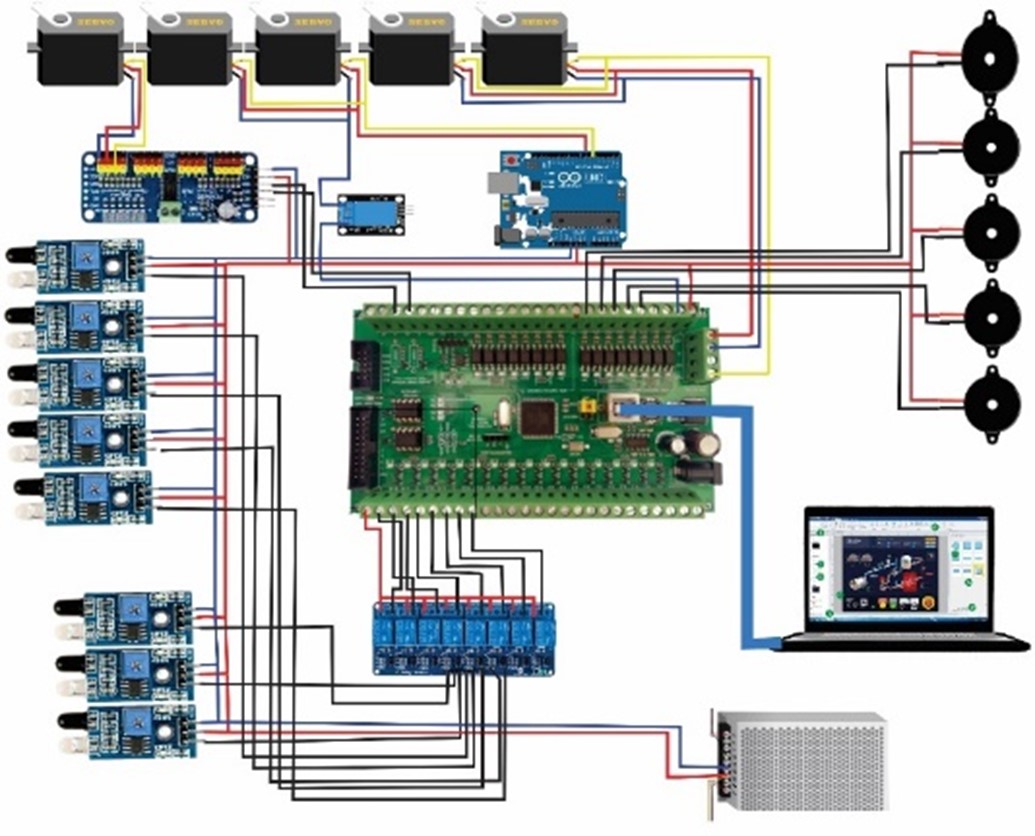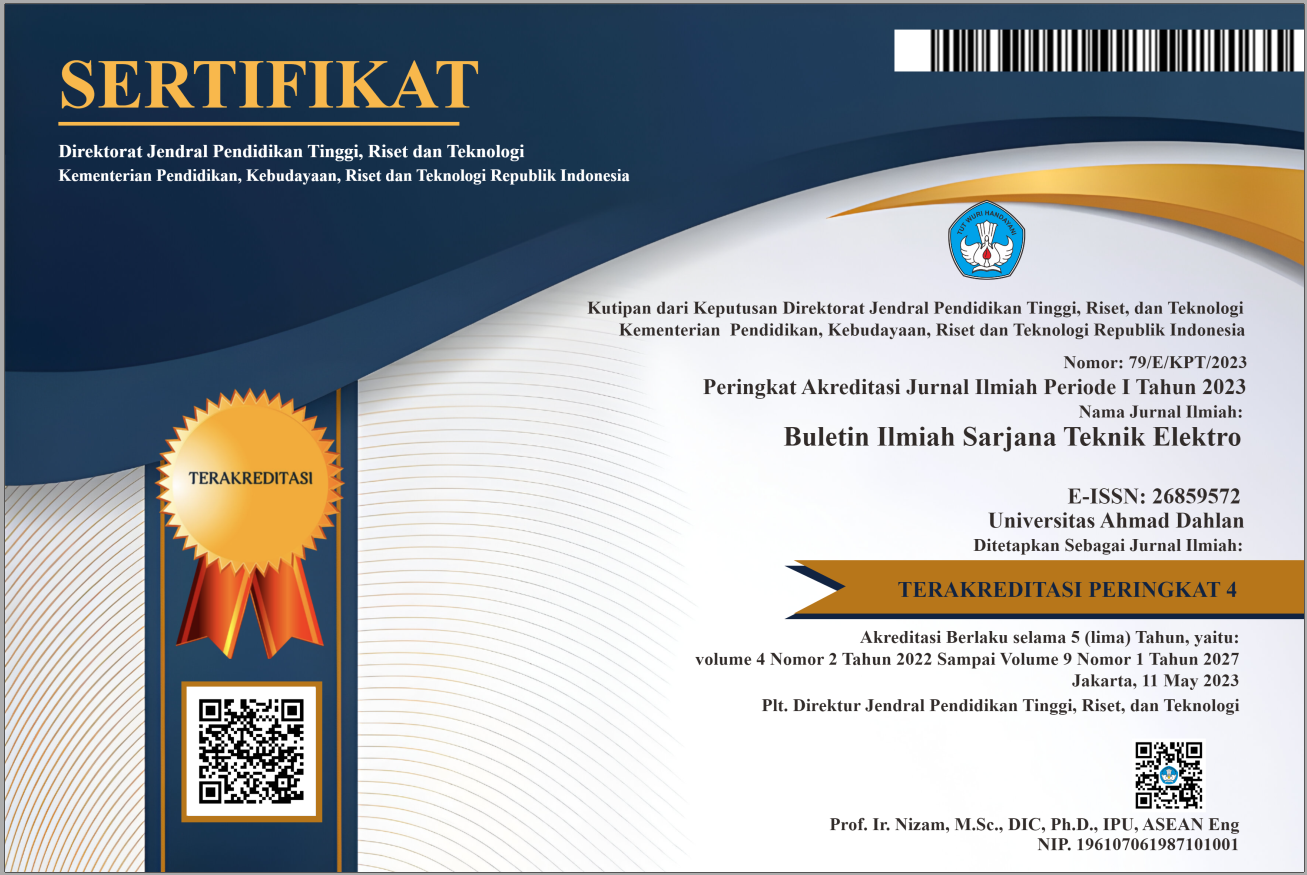Efficiency Through Automation: A Single System for Multiple Railway Guard Posts
DOI:
https://doi.org/10.12928/biste.v5i3.9001Keywords:
Railway Safety, Automation, Guard PostsAbstract
One of the important factors in train travel is the guarding of railroad crossings. Unfortunately, the number of unguarded railway crossings is still quite large. This condition makes it prone to accidents, especially at crossings that are heavily traveled by vehicles. Most of the railway crossing guards in Indonesia use a manual system, where in this system one guard post can only guard one railway crossing, due to limited human resources from PT KAI, many railway crossing doors are not guarded. To reduce accidents and cover the lack of human resources from PT.KAI, an Efficiency tool through Automation was made: One System for Multiple Railway Crossing Guard Posts. This tool is equipped with several main components, namely PLC, HMI, Infrared Sensor, and servo motor. The crossing gate is fully controlled by PLC and HMI as a monitoring system for all components in real-time. By detecting the arrival of the train, the infrared sensor can work by utilizing the movement of the train passing the sensor, not only detecting the arrival of the train, the infrared sensor also works to give orders so that the Servo Motor as a crossing door can be immediately closed and opened on the miniature, the railroad crossing itself is also equipped with an infrared sensor that functions to detect the presence of vehicles in the middle of the railroad crossing controlled by PLC and HMI as a monitoring system. This tool has been tested and the device functions properly and can help reduce the accident rate at railroad crossings.
References
D. V. Efanov, G. V. Osadchii, and V. V. Khoroshev, “New Stage in Safety Traffic Control Technologies Development: Digital Railroad Crossing,” in 2019 International Russian Automation Conference (RusAutoCon), pp. 1–6, 2019, https://doi.org/10.1109/RUSAUTOCON.2019.8867700.
Y. Guo, L. Wan, Y. Zhou, Z. Zhang, and M. Yuan, “Research on the Degradation Process Analysis of the Rail Transit Door System,” in 2020 Global Reliability and Prognostics and Health Management (PHM-Shanghai), pp. 1–5, 2020, https://doi.org/10.1109/PHM-Shanghai49105.2020.9280920.
M. Rath, “Smart traffic management system for traffic control using automated mechanical and electronic devices. In IOP Conference Series: Materials Science and Engineering, vol. 377, no. 1, p. 012201, 2018, https://doi.org/10.1088/1757-899X/377/1/012201.
M. Hamadache, S. Dutta, R. Ambur, O. Olaby, E. Stewart, and R. Dixon, “Residual-based Fault Detection Method: Application to Railway Switch & Crossing (S&C) System,” in 2019 19th International Conference on Control, Automation and Systems (ICCAS), pp. 1228–1233, 2019, https://doi.org/10.23919/ICCAS47443.2019.8971747.
E. Y. Narusova and V. G. Struchalin, “Developing Architecture of Electronic Means of Ensuring the Safe Crossing of Railway Tracks,” in 2021 International Conference on Quality Management, Transport and Information Security, Information Technologies (IT&QM&IS), pp. 85–89, 2021, https://doi.org/10.1109/ITQMIS53292.2021.9642860.
M. I. M. Amjath and T. Kartheeswaran, “An Automated Railway Level Crossing System,” in 2020 International Conference on Image Processing and Robotics (ICIP), pp. 1–7, 2020, https://doi.org/10.1109/ICIP48927.2020.9367346.
K. Shimura, Y. Tomioka, and Q. Zhao, “An Efficient Scene Recognition System of Railway Crossing,” in 2020 11th International Conference on Awareness Science and Technology (iCAST), pp. 1–6, 2020, https://doi.org/10.1109/iCAST51195.2020.9319497.
P. Sikora, M. Kiac, and M. K. Dutta, “Classification of railway level crossing barrier and light signaling system using YOLOv3,” in 2020 43rd International Conference on Telecommunications and Signal Processing (TSP), 2020, https://doi.org/10.1109/TSP49548.2020.9163535.
N. C. Brintha, C. V. P. Tarun, L. Abhishikth, B. P. K. Rao, and M. T. Reddy, “Smart Railway Crossing Surveillance System,” in 2022 International Conference on Computing, Communication, Security and Intelligent Systems (IC3SIS), pp. 1–5, 2022, https://doi.org/10.1109/IC3SIS54991.2022.9885699.
B. P. P. Varna, D. Bhaskar, A. H. M, and V. K. Agrawal, “Solution to Unmanned Railway Crossing Using Satellite and GPS Based Approach,” in 2018 4th International Conference for Convergence in Technology (I2CT), pp. 1–4, 2018, https://doi.org/10.1109/I2CT42659.2018.9058149.
A. A. Amusan and Y. K. Adebakin, “An Automatic Railway Level Crossing System with Crack Detection,” in 2022 5th Information Technology for Education and Development (ITED), pp. 1–7, 2022, https://doi.org/10.1109/ITED56637.2022.10051357.
Z. Wang and L. Liu, “Research on Linkage Control Strategy of Train Door and Platform Door Based on Automatic Driving Technology,” in 2019 IEEE 3rd Information Technology, Networking, Electronic and Automation Control Conference (ITNEC), pp. 1989–1992, 2019, https://doi.org/10.1109/ITNEC.2019.8729537.
E. N. Ardina, E. D. Wardihani, and S. B. Kuntardjo, “The Track Characteristics and The Propagation Model in Train Traffic For Automatic Traffic Door System,” in 2019 6th International Conference on Information Technology, Computer and Electrical Engineering (ICITACEE), pp. 1–62019, https://doi.org/10.1109/ICITACEE.2019.8904223.
K. Shimura, Y. Tomioka, and Q. Zhao, “A Distance Estimation Method to Railway Crossing Using Warning Signs,” in 2021 IEEE 14th International Symposium on Embedded Multicore/Many-core Systems-on-Chip (MCSoC), pp. 178–181, 2021, https://doi.org/10.1109/MCSoC51149.2021.00034.
A. Rehman, S. Latif, and N. A. Zafar, “Automata Based Railway Gate Control System at Level Crossing,” in 2019 International Conference on Communication Technologies (ComTech), pp. 30–35, 2019, https://doi.org/10.1109/COMTECH.2019.8737833.
K. R. Ahmed, M. A. Hossain, A. Akter, and L. Akthar, “A Secure Automated Level Crossing and Train Detection System for Bangladesh Railway,” in 2022 International Conference on Advancement in Electrical and Electronic Engineering (ICAEEE), pp. 1–4 2022, https://doi.org/10.1109/ICAEEE54957.2022.9836361.
C. Du, S. Dutta, P. Kurup, T. Yu, and X. Wang, “A review of railway infrastructure monitoring using fiber optic sensors,” Sensors and Actuators A: Physical, 303, 111728, 2020, https://doi.org/10.1016/j.sna.2019.111728.
S. Surya, P. Kausik, G. Diyaneshwaran, and R. Raffik, “Railway Gate Automation Using Onboard Computing Techniques,” in 2023 2nd International Conference on Advancements in Electrical, Electronics, Communication, Computing and Automation (ICAECA), pp. 1–4, 2023, https://doi.org/10.1109/ICAECA56562.2023.10200564.
A. S. Pashina, D. A. Trofimov, R. R. Savchuk, and M. V Tokareva, “Organization of Efficient Power Supply for the Railway Crossing Signaling System,” in 2020 IEEE Conference of Russian Young Researchers in Electrical and Electronic Engineering (EIConRus), pp. 1652–1654, 2020, https://doi.org/10.1109/EIConRus49466.2020.9039194.
E. J. Lourenço, M. Oliva, M. A. Estrela and A. J. Baptista, "Multidimensional Design Assessment Model for eco-efficiency and efficiency in aeronautical assembly processes," 2019 IEEE International Conference on Engineering, Technology and Innovation (ICE/ITMC), pp. 1-9, 2019, https://doi.org/10.1109/ICE.2019.8792641.
S. Singh, M. Zuber, M. N. Hamidon, N. Mazlan, A. A. Basri, and K. A. Ahmad, “Classification of actuation mechanism designs with structural block diagrams for flapping-wing drones: A comprehensive review,” Progress in Aerospace Sciences, vol. 132, p. 100833, 2022, https://doi.org/10.1016/j.paerosci.2022.100833.
M. I. DeLosRíos-White, P. Roebeling, S. Valente, and I. Vaittinen, “Mapping the life cycle co-creation process of nature-based solutions for urban climate change adaptation,” Resources, vol. 9, no. 4, p. 39, 2020, https://doi.org/10.3390/resources9040039.

Published
How to Cite
Issue
Section
License
Copyright (c) 2023 Mochammad Hisam Zulwidad, Indah Sulistiyowati

This work is licensed under a Creative Commons Attribution-ShareAlike 4.0 International License.
Authors who publish with this journal agree to the following terms:
- Authors retain copyright and grant the journal right of first publication with the work simultaneously licensed under a Creative Commons Attribution License that allows others to share the work with an acknowledgment of the work's authorship and initial publication in this journal.
- Authors are able to enter into separate, additional contractual arrangements for the non-exclusive distribution of the journal's published version of the work (e.g., post it to an institutional repository or publish it in a book), with an acknowledgment of its initial publication in this journal.
- Authors are permitted and encouraged to post their work online (e.g., in institutional repositories or on their website) prior to and during the submission process, as it can lead to productive exchanges, as well as earlier and greater citation of published work (See The Effect of Open Access).
This journal is licensed under a Creative Commons Attribution-ShareAlike 4.0 International License.


